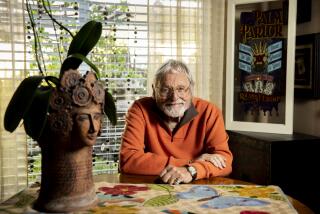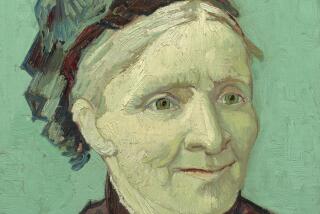One Man’s Junk Is Zorthian’s Idea of Artistic Treasure : Eccentricity: The never-ending work in progress in Altadena attracts notoriety. He’s been called a ‘mountain Toulouse-Lautrec’ and ‘a little bit crazy.’
- Share via
In an instant, Jirayr Zorthian scampered up a narrow iron ladder on a retaining wall at his Altadena ranch.
“Shortcut,” he explained, as he toured his rambling, dust-covered spread in the foothills of the San Gabriel Mountains.
From this vantage point, the painter-sculptor-craftsman-eccentric scanned a landscape heaped with junk: a full-sized telephone booth, heavy-equipment tires, river rocks, rusty metal slats and broken concrete--all grist for the Zorthian artistic mill.
To him, everything is a work in progress. “I have 40 more years of work,” Zorthian said. “I’m 79 now. So, 40 years from now. . . .” he paused for emphasis. “I’ll be 119.”
A visit to the Zorthian art ranch makes clear that he has no intention of relinquishing any of his roles--as rattlesnake handler, horse breeder, architect, painter, winemaker, hog butcher, lover of life and raconteur extraordinaire.
Shirtless and in shorts on a recent day, Zorthian walked the ups and downs and sideways of his ranch, 45 acres of chaparral perched 2,000 feet above sea level, with the rest of Altadena and Pasadena covered in smog below. This place--rich in textures, shapes and smells--has been his home since he left the U.S. Army Intelligence Corps after World War II.
Although by no means a famous artist, the Yale-educated painter has exhibited around the country and the world. As a teacher and mentor, he has inspired many. In Pasadena art circles, his reputation for eccentricity has grown to mythic proportions.
“You go to these boring, liberal parties and there he is having a great time, wearing a hand-tooled leather top hat and colorful vests,” said Pasadena arts activist Dorothy Garcia. “He’s like a half-man, half-horse, a centaur with Pan influences, dancing on tables. He’s sort of a mountain Toulouse-Lautrec.”
Zorthian gained fame in the best-selling book “Surely You’re Joking, Mr. Feynman!” The author, the late Richard P. Feynman, a Nobel Prize-winning physicist at Caltech, recounted how Zorthian, taken by Feynman’s bongo drum playing at a party, ran into the bathroom and sprayed designs in shaving cream on his hairy chest. When he returned, Zorthian had cherries hanging from his ears.
“Naturally, this crazy nut and I became good friends right away,” Feynman wrote.
Decades after the bongo-inspired dance, Zorthian is still exploring his own laws of physics and art.
He is known for hosting exotic banquets with a robust blend of intellectuals, scientists, movie stars and artists in attendance. Pilgrims such as actor Burgess Meredith, futurist R. Buckminster Fuller, Bob Hope’s wife, Dolores, and comedian Cheech Marin have journeyed up the dusty switchbacks to see the ranch’s wonders.
One of those who relishes Zorthian’s feasts is Albert R. Hibbs, now retired after years of prominence as a Jet Propulsion Laboratory scientist. He said, “(Zorthian) is often a little bit crazy, but in such a pleasant way.”
In 1973, William Agee, then the director of the Pasadena Museum of Modern Art (later taken over by the Norton Simon Museum), said Zorthian’s “entire ranch is a living work of art. . . . The distinction between architecture and art is difficult to tell.”
Proudly, Zorthian said, “This entire property has sort of been sculpted with a skip-loader.”
The sculpture, part art and part function, takes various forms. The most famous are his walls, which curb erosion on the mountainside and embody his visions.
“This is a controlled artistic situation,” Zorthian said, pointing to his favorite wall, taller than he is and sloping with the earth’s contour.
Encased amid the mortar and stone are a shovel, a piece of a tree that shaded Zorthian’s studio with bright yellow flowers before it died, and a baby doll with a hair-loss problem (Lady Godiva, he explained) on a ceramic horse.
Another totem contains a series of metal strips behind a rusted radiator. On each strip is inscribed Zorthian’s version of the seven deadly sins: “Judgmental. Indulgence. Vanity. Anger. Anxiety. Procrastination. Gluttony.”
Soon, Zorthian said, he hopes to finish his decades-in-production, three-story, creosote-colored barn/house made of telephone poles. Scores of bottle-glass electrical insulators stud the outside walls.
He and his wife, Dabney, 56, live in a stone farmhouse, chockablock with artifacts and art, including the governor of Tennessee’s 1987 declaration that Zorthian is a “Tennessee Colonel” because of the mural he painted in 1938 in the state capitol.
One notable attraction on his ranch is buried behind a wall of rusting items. It’s an elephant Zorthian made for a 1959 exhibit at the Pasadena Museum of Modern Art, constructed from a fire hose, buckets, burlap and rope. Inside the animal’s stomach is a papier-mache missionary’s head.
“I did this in 1959, long before Kienholtz and the others were doing this kind of art and selling it for a fortune,” he said, referring to Edward Kienholtz, whose assemblage “Back Seat Dodge ‘38” is in the Los Angeles County Museum.
As Zorthian surveyed his domain, he quoted an old saying: “ ‘Art is long but life is short.’ You can’t do it all.”
But he added: “Come back in 20 years and you’ll really see something.”
More to Read
The biggest entertainment stories
Get our big stories about Hollywood, film, television, music, arts, culture and more right in your inbox as soon as they publish.
You may occasionally receive promotional content from the Los Angeles Times.










